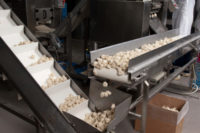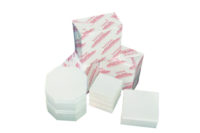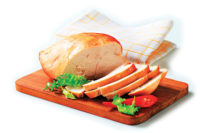Keep it Clean
Andy Hanacek,
executive editor
executive editor
Although speed and efficiency perch high atop the list of demands for form/fill/seal equipment, processors also must consider sanitation and hygiene when choosing a system.
When it comes to form/fill/seal machines and their role in packaging the food consumers eat, suppliers take speed and efficiency to the brink when designing new machines. But in the meat- and poultry-processing industries, a more important aspect of production comes into play: the ability to quickly and thoroughly clean the machines and keep safe the product that passes through them.
“The most important priority for any meat or poultry operation is sanitation and hygiene, and the design of the thermoform/fill/ seal system is key to ensuring the packaging line meets the highest standards,” says Bob Koch, director of sales, Food Division at Multivac, Inc. “We’ve invested enormous resources in the hygienic design of our machinery so that they wash down easily and are not conducive to the accumulation of liquids or food particles that can contaminate product.”
Michael Forbes, marketing manager at Formost Packaging Machines, Inc., agrees that washdown is important in the harsh environments that meat and poultry plants harbor. He adds that in meat and poultry applications, the films also can be different from other areas of the food industry.
“Modifications may be needed to ensure seal integrities of these films,” Forbes continues.
“Modified-atmosphere packaging is more prevalent in this industry, requiring machinery modifications to introduce new gases or evacuate oxygen.”
It is up to suppliers to provide these changes, but keep their ears open to other demands that processors are making in the form/fill/seal arena, says Burt Cristina, product specialist, Packaging, at CFS Americas Region. Some of the processors’ demands, he offers, include machines that are operator-friendly and flexible, include multi-language controls and quick die-set changeovers, or can reach maximum speeds of 15 cycles or more for optimum efficiency.
Many options are available to processors in their search for advanced form/fill/seal equipment that meets the demands listed above. PLC controls and improved data recording are only two of the advancements that Cristina uses as examples.
“Control advancements are allowing PC-based controls to run at speeds equaling the best PLC systems,” Cristina says. “This approach allows complete integrated machine controls and data collection in one package, lowering [total cost of ownership].”
CFS can provide complete systems, and offers turnkey upstream and downstream solutions, including peeling, slicing, loading, offloading, labeling and many others, Cristina relays.
Machines offered by CFS are designed to handle a wide range of film, from flexible to rigid applications, without the need for calibration, and the company also is a film supplier for specialized rigid modified-atmosphere packaging. The company has its eye on sanitation and hygiene as well, committing itself to providing equipment based on the American Meat Institute’s 10 Principles of Sanitary Design.
Koch says that AMI’s design principles are a definite starting point for suppliers who specialize in form/fill/seal machines that will serve the meat and poultry industries.
“Machines must be designed with an understanding of all the implications of operating in a wet versus dry environment,” he explains. “[Multivac has] engineered what we believe to be the industry’s most sanitation-friendly system and have certifications from independent organizations like Dairy 3-A which support that.”
Formost, for its part, has addressed sanitation and hygiene, as well as the more stringent package integrity requirements that the meat and poultry industries require, Forbes adds.
“New ovenable films are being introduced,” he says. “These films have high heat tolerances which require sealers to run higher than in other applications. This can affect the operating speeds adversely [since] more heat may need to be applied for longer times in order to provide strong, quality seals.”
The company’s Fuji-Formost Alpha VI Servo Wrappers feature a new IH (Induction Heating) heater with brushless connector for the fin seals. The machines provide quicker and more exact sealing temperature control, reduce product changeover time, save energy and are maintenance-free.
“Each heater is controlled individually to adjust the fin and end seal temperatures to match film and product speed,” Forbes explains. “This can be pre-programmed and memorized in the computer for easy product changeover. The temperature control system is extremely accurate and dependable.”
Multivac says switching to its thermoform/fill/seal system is very likely to boost a plant’s efficiency and lower costs. For example, processors can use the company’s FormShrink system to create customized shrink packaging inline rather than using shrink bags.
“This creates a great deal of savings in labor and materials while significantly boosting output,” Koch says. “Inline labeling and coding are also available with most systems, and these contribute further to production efficiency.”
Boosting the bottom line by increasing efficiency, speed and the overall safety of the production lines is the name of the game when it comes to form/fill/seal packaging areas of meat and poultry plants. NP



Report Abusive Comment